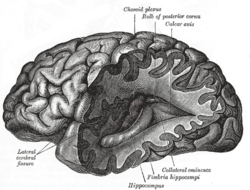Neurobioengineering
In 1995, professor Massimo Grattarola of the Biophysics and Electrical Engineering Department (DIBE) at the University of Genova, in Genova, Italy, created an undergraduate and graduate program named neurobioengineering (also referred to as neuroengineering).[1] The program was designed to amalgamate anthropomorphic robotics, artificial intelligence, bioelectronics,[2] electrical engineering, molecular biology, physics, and medicine, into a single program with the aim of developing advanced bio-compatible neuro-prosthetic implants (man-machine interfacing) for a variety applications (e.g. nervous system interaction with artificial limbs, central and peripheral nervous system implants, directional neural grafting (neural engineering), electron harvesting from biological processes to power implanted devices, neural arrays cultured on CMOS sensors, etc.).[3][4][5][6][7][8]
Neurobioengineering deals with the study and application of bio-compatible neuro-prosthetic implants, neural sensors and interfaces with the nervous system.
The goal of that branch is to develop a bio-artificial brain of cultured neurons capable of replicating human behaviour in an artificial robotic system. The European Union F.E.T. funded the neurobioengineering department to pursue this ambitious project.[9]
History
The neurobioengineering program spawned numerous journal publications by the departmental scientific pioneers (Dr. Marco Bove, Dr. Sergio Martinoia, Dr. Renato Zaccaria, and many others) and a university course textbook Bioelectronics, MOSFETS, Biosensors and Neurons [2] published by Massimo Grattarola. Members of the department were collaborating with researchers throughout the European Union, Japan and North America. Students from throughout the European Union and Canada enrolled in the program.
Comparable international efforts
At the time (1995), a small number of universities offered specialized bioelectronics and/or implantable neuro-prostheses-related research (but no specialized undergraduate programs) internationally for example: University of Utah, MIT, UCSF (United States); McGill University (Canada), among others.
First European School on Neuroengineering
In 2003, following professor Grattarola's death, the University of Genova announced Europe's first neurobioengineering conference in his honour.[10] The First European School on Neuroengineering 'Massimo Grattarola' was also founded in 2004, with the goal of establishing a long-term formal educational program to foster future pioneers in neurobioengineering.[11]
In a state of transition, the neurobioengineering department renamed itself the neuroengineering and bio-nanotechnology group in 2005. By 2008, the core researchers of the original department had formalized the educational process into a formal long-term program at the University of Genova named School of Neuroengineering, fulfilling Massimo Grattarola's original ambitions, offering degrees in Humanoid Technologies.[12]
The current and former neurobioengineering (or neuroengineering) students continue his research interests throughout Europe and North America, some of whom have established related businesses, or hold positions of authority in neuroscience/biomedical institutions worldwide.
External links
References
- ↑ Dr. Marco Bove, In Memoriam Website for Dr. M. Grattarola, University of Genova, Italy - http://web.archive.org/web/20020714024312/http://www.bio.dibe.unige.it/people/Grattarola/grattarola.htm
- 1 2 Bioelectronics - MOSFETs, Biosensors and Neurons - M. Grattarola, McGraw-Hill; April 8, 1998. English. ISBN 0-07-003174-6. ISBN 978-0-07-003174-6
- ↑ Neural Computation, Volume 11, Issue 6 (August 1999), Pages: 1413 - 1426 : 1999, ISSN 0899-7667, Michele Giugliano, Marco Bove, Massimo Grattarola
- ↑ Michele Giugliano, Marco Bove, Massimo Grattarola: Activity-Driven Computational Strategies of a Dynamically Regulated Integrate-and-Fire Model Neuron. Journal of Computational Neuroscience 7(3): 247-254 (1999)
- ↑ Michele Giugliano, Massimo Grattarola, Gwendal Le Masson: Electrophysiological activity to cell metabolism signal transduction. Neurocomputing 38-40: 23-30 (2001)
- ↑ Michele Giugliano, Marco Bove, Massimo Grattarola: Fast Calculation of Short-Term Depressing Synaptic Conductances. Neural Computation 11(6): 1413-1426 (1999)
- ↑ An array of H+ FETs for space-resolved electrochemical measurements. Sensors and Actuators B: Chemical Volume 24, Issues 1-3, March 1995, Pages 218-221
- ↑ Molecular Crystals and Liquid Crystals Authors: Massimo Grattarola; Sergio Martinoia; Giuseppe Massobrio; Marco Bove; Carlo Ciccarelli. doi:10.1080/10587259308055215
- ↑ Institute of Physics, Journal of Neural Engineering Vol 5, Issue 4. http://www.iop.org/EJ/article/1741-2552/2/4/E01/jne5_4_e01.pdf?request-id=6f3a87c4-a31f-486e-b2b0-3756a52e060c
- ↑ Abstract Paper Neuroengineering School http://www.neuroinf.org/lists/comp-neuro/2003/0037.shtml
- ↑ http://www.unige.it
- ↑
- ^ Neuroengineering School http://www.neuro-it.net/pipermail/general/2003-April/000018.html
